Today, Rep. Cindy Axne (IA-03) introduced legislation that requires more oversight of rental properties that are subsidized by U.S. Department of Agriculture (USDA) and Department of Housing and Urban Development (HUD) to ensure landlords are maintaining safe and quality housing.
Many housing units offered by USDA and HUD have fallen behind on maintenance and upkeep, due in a large part to a lack of funding. USDA’s Section 515 multifamily program’s projected capital needs have reached $10 billion, while USDA has not financed new development for this program since 2011.
This underinvestment, in addition to a lack of inspection and oversight, has led to major problems at federally-backed properties. This includes fires earlier this year at buildings in New York and Philadelphia that killed 29 people, as well as significant issues at USDA federally backed properties in Iowa managed by Truverse Management and Carlson Property Holdings and Management, including broken roofs, no heat or air conditioning, inoperable fire doors, and other poor conditions.
“I am disturbed by reports that Iowans are living in filthy and unsafe conditions while renting federally subsidized housing,” said Rep. Axne. “Renters deserve more oversight of federally backed housing to ensure they have quality, affordable places to live and landlords who receive subsidies to maintain their properties should be using their money to do so.”
While HUD has begun modernizing their inspection standards to the National Standards for the Physical Inspection of Real Estate (NSPIRE), which will include safety standards around smoke alarms and a process for tenant feedback, that system is not yet implemented fully. In addition, inspections at USDA properties do not use the same process as HUD, leading to a lack of clarity and risks to the tenants of unsafe conditions even while the landlord is receiving federal funds.
The legislation:
The Safe at Home Act would require that within 12 months, the HUD Secretary and USDA Secretary review the laws, regulations, and requirements governing each of their respective housing inspection processes, and identify which procedures best protect residents.
The two Departments will then have 12 months to jointly issue regulations to implement the requirements for inspection and safety that best protect residents of federally backed housing while considering the type of housing (for example, single family homes vs. apartment buildings) that is being supported and inspected.
This process will serve to better protect the residents of these properties and the communities they live in, and ensure that federal funding is being properly used to benefit the residents it is intended to support.
Original source can be found here


